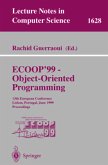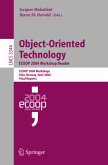In recent years, concepts in object-oriented modeling and programming have been extended in several directions, giving rise to new paradigms such as age- orientation and feature-orientation. This volume came out of a Dagstuhl seminar exploring the relationship - tween the original paradigm and the two new ones. Following the success of the seminar, the idea emerged to edit a volume with contributions from parti- pants including those who were invited but could not come. The participants reaction was very positive, and so we, the organizers of the seminar, felt - couraged to edit this volume. All submissions were properly refereed, resulting in the present selection of high-quality papers in between the topics of objects, agents and features. The editors got help from a number of additional reviewers, viz. Peter Ahlbrecht, Daniel Amyot, Lynne Blair, Jan Broersen, Mehdi Dastani, Virginia Dignum, Dimitar Guelev, Benjamin Hirsch, Maik Kollmann, Alice Miller, Stephan Rei?-Marganiec, Javier Vazquez-Salceda, and Gerard Vreeswijk. Finally, we would like to take this opportunity to thank all the persons - volvedintherealizationoftheseminarandthisbook:attendees,authors,revi- ers, and, last but not least, the sta? from Schloss Dagstuhl and Springer-Verlag. February 2004 The Editors TableofContents Objects, Agents, and Features: An Introduction. . . . . . . . . . . . . . . . . . . . . . . . 1 John-Jules Ch. Meyer, Mark D. Ryan, and Hans-Dieter Ehrich Coordinating Agents in OO . . . . . . . . . . . . . . . . . . . . . . . . . . . . . . . . . . . . . . . . . 8 Frank S. de Boer, Cees Pierik, Rogier M. van Eijk, and John-Jules Ch. Meyer On Feature Orientation and on Requirements Encapsulation Using Families of Requirements. . . . . . . . . . . . . . . . . . . . . . . . . . . . . . . . . . . . . . 26 Jan Bredereke Detecting Feature Interactions: How Many Components Do We Need?. . . .








